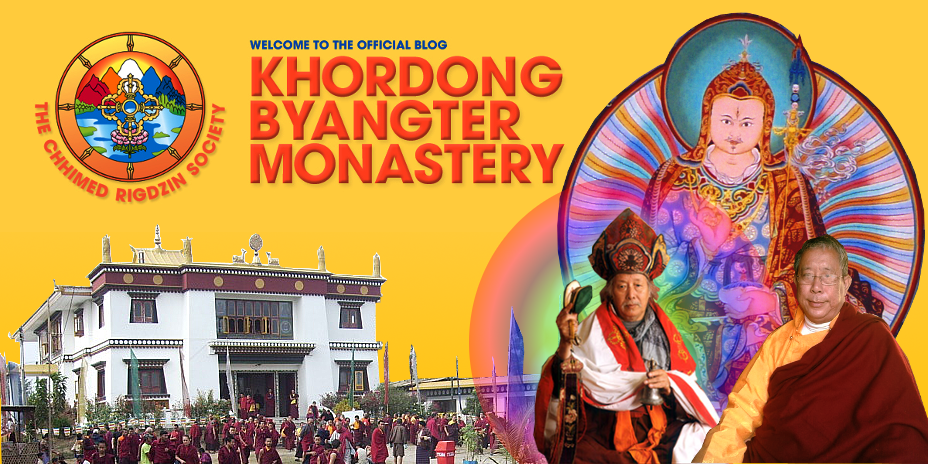Welcoming Chhimed Rigdzin Rinpoche at His monatery, May 1990
The name of my monastery is "Khordong Gompa".It means "one small house in a mountain's corner". In general, people don't know who made this monastery, but we understand that its founder was Nubchen Sangye Yeshe (one of the twenty-five disciples of Padmasambhava), who was a practicionner of Yamantaka.
Nubchen Sangye Yeshe built on the ground a huge Yamantaka mantra's prayer wheel (not in the air, as in general). Due to the ice, in winter times, we can hear it sounding, "grrr, grrr, grrr".
Where is this monastery located?
Generally, we can say that all Tibet is a place of Avalokiteshvara (i.e. his teaching place). But in particular, Padmasambhava (Tsokye Dorje) came to this place, and blessed it. His blessings are very powerful.
In the country called "Drolma Zalma Gang", there is a valley called "Nyikog" where the Nyetshe River flows. There are many great forests, flowers, many various medicine plants, waterfalls, many different kinds of birds, games (like tigers) and mountain animals like dears, etc.
In the upper part, there are plenty of animals producing milk - yaks, sheep, goats, etc. - and therefore there are lots of butter, cheese and milk.
In the lower part, many people are involved with agriculture work, and therefore the crops are consequent. Thus this is a very valuable place.
Concerning the religious aspect, each village has a monastery, as well as a lonely retreat place. Representatives of Shakya, Gelug, Kagyu and Nyingma are many.
Khordong monastery in Kham, in particular, is a Holy Place ("Ba yer Ga wa Long"). There is a Padmasambhava cave, where many dakinis gather, self existing mantras, etc. If you practice in this place, the diseases and obstacles of this life will be extinguished, you will gain the long life power, you will possibly get rich, and you will gain there enlightenment. It is thus near this very place that, in the eight century, Nubchen Sangye Yeshe made this prayer wheel, and for that reason the place has been called "Khor Lo Dong".
Padmasambhava himself recognized the eight auspicious signs self appearing on the mountains valley.
The original Tibetan text has been written by Chhimed Rigdzin Rinpoche, who himself brought it to his monastery of Khordong in Kham (Tibet), in 1990. Marie-Neige Lefevbre brought it back from Tibet in 1997. Chhimed Rigdzin Rinpoche dictated its summarized translation to Nadia Maati and Nathalie Koralnik during the Butterlamp Retreat held on the monastery land, at Dhansara village, Siliguri, in January 1998). Typed in English by Nathalie Koralnik

